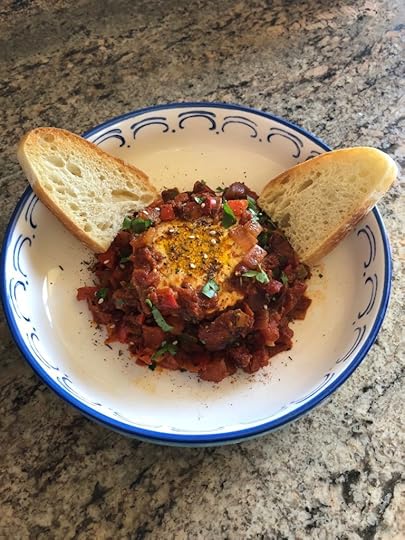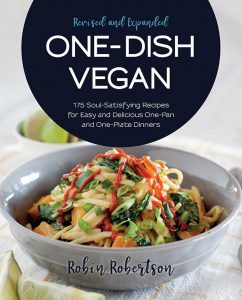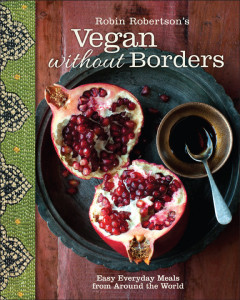Robin Robertson's Blog, page 5
December 20, 2018
Vegan Shakshuka
If you’re looking for something different to wake up your taste buds, this vegan shakshuka may be just the ticket. Tofu replaces poached eggs in this spicy dish that originated in Tunisia. It’s great for brunch or a light supper. I like to serve it with a side of oven-fried potatoes and a salad. Chopped cooked artichoke hearts are a good addition to the zesty sauce and are a good foil for the spicy heat. If you prefer less heat, you can reduce the amount of harissa, red pepper flakes, and/or jalapeno. Serve with warm crusty Italian bread or pita bread.
This is one of the 25 all-new recipes featured in One-Dish Vegan (Revised and Expanded edition).
Vegan Shakshuka
Makes 4 servings
12 ounces firm tofu, drained
1/4 teaspoon turmeric
1/4 teaspoon Indian black salt (kala namak), optional
Salt and ground black pepper
1 tablespoon olive oil
1 red onion, chopped
3 cloves garlic, minced
1 red bell pepper, chopped
1 jalapeño chile, seeded and minced
1 tablespoon smoked paprika
1/2 teaspoon ground cumin
1/4 cup nutritional yeast
2 teaspoons harissa paste or 1/2 teaspoon red pepper flakes
1 teaspoon sugar
1 tablespoon tomato paste
1 (28-ounce) can diced tomatoes, undrained
1 teaspoon Za’atar spices or 1/2 teaspoon dried oregano
Chopped parsley or cilantro, as garnish
Crusty Italian bread or warm pita bread, to serve
1/2 cup vegan unsweetened yogurt
Cut the block of tofu into four 1/2-inch thick slices, and then use a cookie cutter to cut the slices into 4-inch rounds. Save the tofu scraps to use in a scramble or other recipe. Rub kala namak (if using) on the surface of the the tofu rounds. Rub the turmeric in a 1 ½-inch circle in the center of each tofu round. Season with salt and pepper and set aside.
Heat the olive oil in a skillet over medium heat. Add the onion and cook for 5 minutes to soften. Add the garlic, bell pepper, and chile and cook until tender, 5 minutes. Stir in the smoked paprika, cumin, tomato paste, harissa, sugar, tomato paste, and diced tomatoes. Cook, stirring, until slightly saucy, about 4 minutes, mashing any large pieces of tomato. Reduce the heat to low, season with salt and pepper to taste, and simmer for 10 minutes. Arrange the tofu rounds on top of the sauce, pressing down so just the centers show and the rest of the tofu is submerged in the sauce. Simmer for 10 minutes longer to thicken the sauce and heat the tofu.
To serve, sprinkle Za’atar spices and garnish with fresh parsley. Serve with toasted crusty bread or baguette or pita bread and yogurt, if using.
The post Vegan Shakshuka appeared first on Robin Robertson.












November 23, 2018
Tricked-Out Tofurky
This year, we will have Thanksgiving dinner on Saturday with friends, but I couldn’t let the actual day go by without doing at least some cooking — and we LOVE Thanksgiving leftovers!
I happened to pick up a Tofurky roast on sale, but I always end up making a separate baking dish of my own stuffing. This time, I decided to transform the humble Tofurky into a holiday roast to be reckoned with by opening it up, stuffing it with A LOT of stuffing, and wrapping the whole thing in yuba (bean curd skin), before roasting it to perfection.
The actual process happened in a swirl of creativity, so I didn’t stop to take step-by-step photos. I’ll explain what I did:
TRICKED-OUT TOFURKY
Ingredients:
1 recipe of your favorite stuffing, made ahead and refrigerated
1 Tofurky Roast
1 or 2 sheets of frozen yuba (bean curd skin), available in Asian markets, thawed and at room temperature
Method:
1. Make your favorite stuffing ahead of time and refrigerate in a bowl until needed.
2. Cut the ends off the Tofurky and discard the plastic wrapper. Cut about a 1-inch thick slice off the bottom of the Tofurky and place the roast, cut side up, on your cutting board. Cut that 1-inch slice lengthwise into 2 1/2-inch slices and set them aside.
3. Carefully make a cut long-way through the center of the roast stopping just short of cutting all the way through. (The roast should stay in once piece, if possible. Removing the stuffing and adding it to your bowl of stuffing. Cut a few diagonal slits in each side of the inside of the Tofurky, essentially to open it up to be nearly flat. Preheat the oven to 375 degrees F.
4. If your yuba is stiff, place it (folded) in a large mixing bowl with about 1 cup of warm vegetable broth. Let it soak until softened. Carefully open up the yuba sheets and arrange them in the bowl to line it. (You can leave the broth in the bowl.)
5. Place the cut Tofurky in the bowl on top of the yuba, cut-side up, Transfer the stuffing into the bowl on top of the Tofurky, pressing to shape it into an oval. Press the sides of the Tofurky into the stuffing to make a nice oval roast shape. Place the 2 reserved 1/2-inch Tofurky slices on top of the stuffing, pressing them in to make a firm roast.
6. Gather the yuba up and around the sides of the roast so that the roast is entirely wrapped in yuba. Place a sheet of parchment paper on top of the roast and invert a rimmed baking sheet on top. Carefully flip the bowl and baking sheet so that the roast is now on the baking sheet. Remove the bowl.
7. Rub the outside of the roast lightly with oil or spray it lightly with cooking oil spray. Cover with foil and bake for 1 hour. Uncover and bake for about 20 minutes longer or until the yuba is nicely browned.
Transfer the roast to a serving platter (it’s easy to do with the parchment paper — you can then slide out the parchment paper and discard. If your platter is large enough, surround it with roasted veggies. Cut the roast with a serrated knife and serve with gravy.
We really loved the results. I served the roast with roasted butternut squash, Brussels sprouts, and pecans; twice-baked stuffed potatoes; and cranberry sauce.
Assembling the roastwas much easier to do than it sounds, and way more delicious with all the added stuffing and crispy yuba skin. Plus you can serve way more people this way. Win-win, any way you look at it (especially for the turkeys).
The post Tricked-Out Tofurky appeared first on Robin Robertson.












November 13, 2018
Japanese Vegetable Curry
 Milder and thicker than other curries and slightly sweet, Japanese curries are typically thickened with a roux. This Japanese Vegetable Curry from One-Dish Vegan cuts the fat and adds flavor by pureeing some of the vegetables in the curry to thicken it. This is also good made with fresh or frozen shelled edamame instead of the tofu and snow peas instead of the green peas. S&B brand curry powder works best in this dish.
Milder and thicker than other curries and slightly sweet, Japanese curries are typically thickened with a roux. This Japanese Vegetable Curry from One-Dish Vegan cuts the fat and adds flavor by pureeing some of the vegetables in the curry to thicken it. This is also good made with fresh or frozen shelled edamame instead of the tofu and snow peas instead of the green peas. S&B brand curry powder works best in this dish.
Japanese Vegetable Curry

Milder and thicker than other curries and slightly sweet, Japanese curries are typically thickened with a roux. This version cuts the fat and adds flavor by pureeing some of the vegetables in the curry to thicken it. This is also good made with fresh or frozen shelled edamame instead of the tofu and snow peas instead of the green peas. S&B brand curry powder works best in this dish.
2 teaspoons olive oil or ¼ cup (60 ml) water
1 large yellow onion, chopped
2 carrots, peeled and cut into ¼-inch (6 mm) thick slices
1½ to 2 tablespoons (9 to 13 g) yellow curry powder
1½ tablespoons (24 g) tomato paste
1 tablespoon (15 ml) wheat-free tamari
1 to 2 teaspoons agave nectar
¼ teaspoon cayenne pepper, optional
1/3 cup (82 g) applesauce
3 cups (700 ml) vegetable broth
1 large rurusset potato, peeled and cut into 1-inch (2.5 cm) dice
Salt and freshly ground black pepper
1 tablespoon (16 g) mellow miso paste
8 ounces (225 g) extra-firm tofu, well drained, blotted dry, and diced
¾ cup (113 g) fresh or (98 g) thawed frozen peas
Heat the olive oil or water in a large pot over medium heat. Add the onion and cook until softened, about 5 minutes. Add the carrots and then stir in the curry powder, tomato paste, tamari, agave, cayenne (if using), applesauce, and broth and bring to a boil. Reduce the heat to a simmer and add the potato and salt and pepper to taste. Simmer until the vegetables are tender, about 30 minutes.
Transfer about 2 cups (455 g) of the mixture to a high-speed blender or food processor. Add the miso paste and puree until smooth. Stir the vegetable puree back into the curry along with the tofu and peas and simmer for 5 minutes longer. Taste and adjust the seasonings if needed.
Serve hot.
From One-Dish Vegan by Robin Robertson © 2018 Quarto Publishing Group USA Inc. Used with permission.
The post Japanese Vegetable Curry appeared first on Robin Robertson.












November 6, 2018
One-Pot Sicilian Couscous
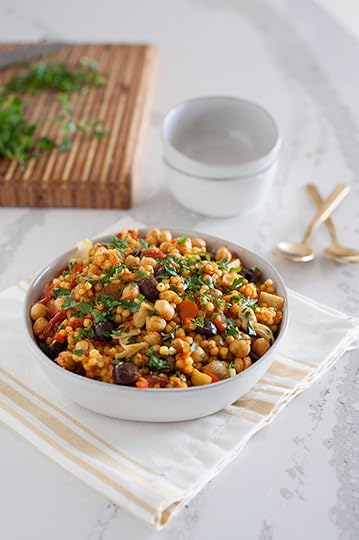 Israeli (pearl) couscous is larger than regular couscous, giving it more flavor and texture. It is especially delicious in this One-Pot Sicilian Couscous dish from One-Dish Vegan made with chickpeas, olives, and an assortment of vegetables.
Israeli (pearl) couscous is larger than regular couscous, giving it more flavor and texture. It is especially delicious in this One-Pot Sicilian Couscous dish from One-Dish Vegan made with chickpeas, olives, and an assortment of vegetables.
One-Pot Sicilian Couscous
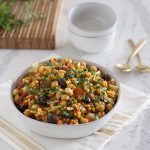
Israeli (pearl) couscous is larger than regular couscous, giving it more flavor and texture. It is especially delicious in this Sicilian-spiced dish made with chickpeas, olives, and an assortment of vegetables.
1 tablespoon (15 ml) olive oil or ¼ cup (60 ml) water
1 onion, finely chopped
1 carrot, thinly sliced
1 red bell pepper, chopped
3 garlic cloves, minced
4 plum tomatoes, chopped or 1 can (14 ounces, or 400 g) of diced tomatoes, undrained
1 teaspoon dried basil
½ teaspoon ground saffron or turmeric
¼ teaspoon ground paprika
1½ cups (246 g) cooked chickpeas or 1 can (15.5 ounces, or 440 g) of chickpeas, rinsed and drained
1¼ cup (219 g) uncooked Israeli (pearl) couscous
2 cups (475 ml) vegetable broth
¼ teaspoon red pepper flakes
Salt
1 jar (12 ounces, or 340 g ) of marinated artichoke hearts, drained and chopped
½ cup (85 g) Kalamata olives, halved and pitted
2 tablespoons (28 ml) fresh lemon juice
Freshly ground black pepper
2 tablespoons minced fresh (8 g) parsley or (5 g) basil
Heat the olive oil or water in a medium saucepan over medium-high heat. Add the onion, carrot, bell pepper, and garlic. Cook, stirring, for 5 minutes to soften the vegetables. Stir in the tomatoes, dried basil, saffron, and paprika. Stir in the chickpeas, couscous, broth, and red pepper flakes. Season with salt to taste. Bring to a boil and then reduce the heat to a simmer, cover, and cook for 10 minutes.
Remove from the heat and let stand, covered, for 10 minutes longer or until all the liquid has been absorbed. Add the artichoke hearts, olives, and lemon juice and season with black pepper just before serving. Fluff the couscous with a fork. Sprinkle with parsley and serve hot.
From One-Dish Vegan by Robin Robertson © 2018 Quarto Publishing Group USA Inc. Used with permission.
The post One-Pot Sicilian Couscous appeared first on Robin Robertson.












October 30, 2018
Coconut Curry Noodles and Butternut Squash
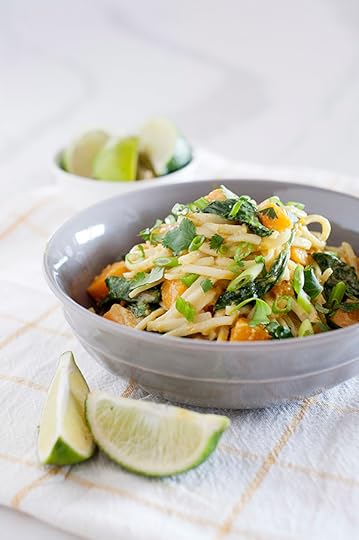 Butternut squash adds a touch of sweetness to the coconut-curry sauce in this Coconut Curry Noodles recipe from One-Dish Vegan. Mix and match vegetables or make it as spicy as you like—begin with as much or as little cayenne as you like and then garnish with sriracha or sambal oelek for more heat.
Butternut squash adds a touch of sweetness to the coconut-curry sauce in this Coconut Curry Noodles recipe from One-Dish Vegan. Mix and match vegetables or make it as spicy as you like—begin with as much or as little cayenne as you like and then garnish with sriracha or sambal oelek for more heat.
Coconut Curry Noodles and Butternut Squash

Butternut squash adds a touch of sweetness to the coconut-curry sauce. Mix and match vegetables or make it as spicy as you like—begin with as much or as little cayenne as you like and then garnish with sriracha or sambal oelek for more heat.
2 teaspoons neutral vegetable oil
3 shallots (chopped)
1 tablespoon (8 g) grated fresh ginger
3 tablespoons (45 ml) wheat-free tamari
1 tablespoon (6 g) yellow curry powder
2 teaspoons ground coriander
¼ teaspoon cayenne, or to taste
2 teaspoons sugar
Salt and freshly ground black pepper
2 cups (475 ml) vegetable broth
1 small butternut squash, peeled and cut into ½-inch (1.3 cm) dice (about 3 cups)
8 ounces (225 g) dried rice noodles
2 cups (140 g) chopped bok choy or other leafy greens
1 can (14 ounces, or 395 ml) of unsweetened coconut milk
½ cup (8 g) chopped fresh cilantro
2 scallions, chopped
Lime wedges, to serve
Sriracha or sambal oelek, to serve (optional)
Heat the vegetable oil in a large pot over medium heat. Add the shallot and ginger and cook, stirring, for 1 minute to soften. Stir in the tamari, curry powder, coriander, cayenne, sugar, and salt and pepper to taste.
Stir in the broth and then add the squash. Bring to a boil and then reduce the heat to a simmer. Cover and cook for 20 minutes or until the squash is tender. Add the bok choy and simmer for another 10 minutes.
While the vegetables are cooking, soak the rice noodles in a bowl of hot water and set aside. When the noodles are soft, drain them and add them to the vegetables.
Stir in the coconut milk and heat until hot—but do not boil. Taste and adjust the seasonings if needed.
Serve in large bowls and garnish with cilantro and scallions. Serve with lime wedges and sriracha (if using).
From One-Dish Vegan by Robin Robertson © 2018 Quarto Publishing Group USA Inc. Used with permission.
The post Coconut Curry Noodles and Butternut Squash appeared first on Robin Robertson.












October 23, 2018
Vegan Chili Verde
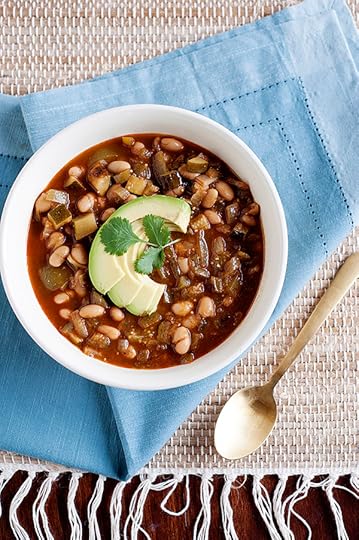 Chili is always a cold weather favorite, and this vegan Chili Verde from One-Dish Vegan is a fun twist on the classic dish.
Chili is always a cold weather favorite, and this vegan Chili Verde from One-Dish Vegan is a fun twist on the classic dish.
Fresh tomatillos look like small green tomatoes in papery husks, and they have a slightly tart flavor. If fresh ones are unavailable, use the canned variety. Salsa verde, a green salsa, is available in most supermarkets. I use less chili powder than usual in this recipe to try to retain as much of the green color of the chili as possible. If you prefer additional chili powder, add it according to taste. When Lori Maffei tested the recipe, we discussed how nice it would be to have white chili powder and—guess what? — she found some online! I haven’t tried it yet, but it sounds intriguing.
Chili Verde
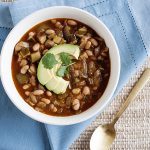
Fresh tomatillos look like small green tomatoes in papery husks, and they have a slightly tart flavor. If fresh ones are unavailable, use the canned variety. Salsa verde, a green salsa, is available in most supermarkets. I use less chili powder than usual in this recipe to try to retain as much of the green color of the chili as possible. If you prefer additional chili powder, add it according to taste. When Lori Maffei tested the recipe, we discussed how nice it would be to have white chili powder and—guess what? — she found some online! I haven’t tried it yet, but it sounds intriguing.
1 tablespoon (15 ml) olive oil or ¼ cup (60 ml) water
1 medium-size yellow onion, chopped
3 garlic cloves, minced
1 large green bell pepper, seeded and chopped
1 medium-size zucchini, chopped
1 or 2 jalapeño chiles, seeded and minced
1½ cups (198 g) husked and chopped tomatillos, or 1 can (14 ounces, or 395 g) of tomatillos, drained and chopped
1 cup (256 g) salsa verde
1 to 2 tablespoons (8 to 15 g) chili powder
1 teaspoon dried oregano
1 teaspoon ground cumin
Salt and freshly ground black pepper
1½ cups (355 ml) vegetable broth or water, plus more if needed
3 cups (531 g) cooked Great Northern or other white beans or 2 cans (15.5 ounces, or 440 g each) of Great Northern or other white beans, rinsed and drained
1 ripe Hass avocado, for serving
¼ cup chopped fresh (4 g) cilantro or (15 g) Italian parsley, for serving
Heat the olive oil or water in a large pot over medium heat. Add the onion, garlic, bell pepper, zucchini, and jalapeños. Cook, stirring, until the vegetables begin to soften, about 5 minutes. Add the tomatillos, salsa verde, chili powder, oregano, cumin, and salt and pepper to taste.
Add the broth and beans and bring to a boil. Reduce the heat to a simmer and cook, stirring occasionally, until the vegetables are tender, about 40 minutes. Add more broth if the chili becomes too thick.
Taste and adjust the seasonings if needed. When ready to serve, pit, peel, and dice the avocado. Top each serving with avocado and cilantro and serve hot.
From One-Dish Vegan by Robin Robertson © 2018 Quarto Publishing Group USA Inc. Used with permission.
The post Vegan Chili Verde appeared first on Robin Robertson.












October 16, 2018
Caribbean Greens and Beans Soup
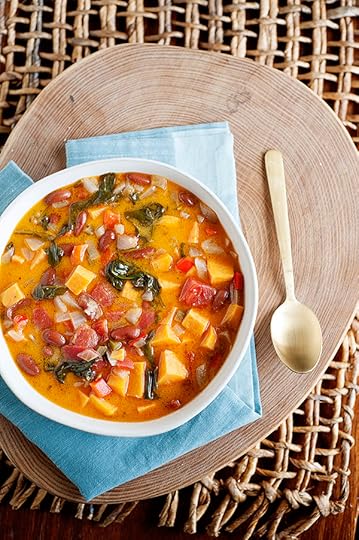 This Caribbean Greens and Beans Soup is inspired by a delicious Jamaican soup made with callaloo (taro) leaves in a light coconut broth. My version calls for the more readily available spinach, although cabbage, kale, or chard may be used instead. The soup has a nice heat from the jalapeños, but you can omit them for a milder flavor or increase them if you want more heat.
This Caribbean Greens and Beans Soup is inspired by a delicious Jamaican soup made with callaloo (taro) leaves in a light coconut broth. My version calls for the more readily available spinach, although cabbage, kale, or chard may be used instead. The soup has a nice heat from the jalapeños, but you can omit them for a milder flavor or increase them if you want more heat.
Caribbean Greens and Beans Soup

This soup is inspired by a delicious Jamaican soup made with callaloo (taro) leaves in a light coconut broth. My version calls for the more readily available spinach, although cabbage, kale, or chard may be used instead. The soup has a nice heat from the jalapeños, but you can omit them for a milder flavor or increase them if you want more heat.
1 tablespoon (15 ml) olive oil or ¼ cup (60 ml) water
1 medium-size red onion, chopped
3 garlic cloves, chopped
2 medium-size sweet potatoes, peeled and diced
1 medium-size red bell pepper, seeded and chopped
1 or 2 jalapeños or other hot chiles, seeded and minced
1 can (14.5 ounces, or 410 g) of diced tomatoes, drained
1½ cups (266 g) cooked dark red kidney beans or 1 can (15.5 ounces, or 440 g) of dark red kidney beans, rinsed and drained
4 cups (950 ml) vegetable broth
2 teaspoons fresh thyme or 1 teaspoon dried thyme
¼ teaspoon ground allspice
Salt and freshly ground black pepper
9 ounces (255 g) baby spinach
1 can (13.5 ounces, or 380 ml) of unsweetened coconut milk
Heat the olive oil or water in a pot over medium-high heat. Add the onion and sauté for 5 minutes. Add the garlic and cook for 1 minute longer. Add the sweet potatoes, bell pepper, jalapeño, tomatoes, and beans. Stir in the broth, thyme, and allspice and season to taste with salt and pepper. Bring to a boil and then reduce the heat to a simmer and cook until the vegetables are tender, about 30 minutes.
Stir in the spinach and coconut milk, stirring to wilt the spinach. Taste and adjust the seasonings. Cook for 5 to 10 minutes longer to wilt the spinach and blend the flavors. Taste and adjust the seasonings if needed. Serve hot.
From One-Dish Vegan by Robin Robertson © 2018 Quarto Publishing Group USA Inc. Used with permission.
The post Caribbean Greens and Beans Soup appeared first on Robin Robertson.












October 9, 2018
Smoky Chickpea Salad with Mango and Avocado
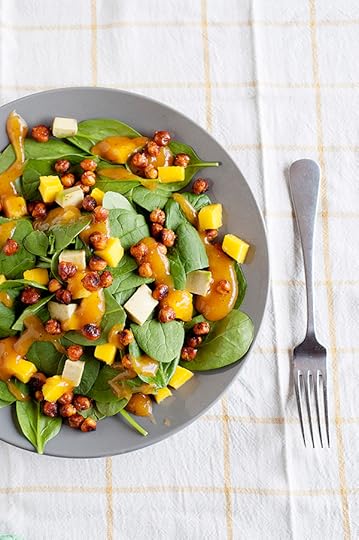 Today is publication day for One-Dish Vegan Revised and Expanded Edition! To celebrate, I’m sharing my recipe for Smoky Chickpea Salad with Mango and Avocado from the book.
Today is publication day for One-Dish Vegan Revised and Expanded Edition! To celebrate, I’m sharing my recipe for Smoky Chickpea Salad with Mango and Avocado from the book.
Roasted chickpeas were a favorite snack of my grandmother, who first introduced me to the savory, protein-rich treat many years ago. These days you can find spin-offs of classic roasted chickpeas that feature various spice blends and sauces from curry to tamari. This one takes a smoky route. Once roasted, the chickpeas take on a lovely mahogany color and a deep smoky flavor that complements the other salad components. The luscious mango dressing can be made with your choice of Dijon mustard or sriracha sauce.
Smoky Chickpea Salad with Mango and Avocado

Roasted chickpeas were a favorite snack of my grandmother, who first introduced me to the savory, protein-rich treat many years ago. These days you can find spin-offs of classic roasted chickpeas that feature various spice blends and sauces from curry to tamari. This one takes a smoky route. Once roasted, the chickpeas take on a lovely mahogany color and a deep smoky flavor that complements the other salad components. The luscious mango dressing can be made with your choice of Dijon mustard or sriracha sauce.
Smoky Chickpeas:
1 tablespoon (15 ml) pure maple syrup
1 tablespoon (15 ml) wheat-free tamari
2 teaspoons liquid smoke
2 teaspoons olive oil
1 teaspoon nutritional yeast
1 teaspoon smoked paprika
½ teaspoon onion powder
¼ teaspoon freshly ground
black pepper
¼ teaspoon salt
1½ cups (246 g) cooked chickpeas or 1 can (15.5 ounces, or 440 g) of chick-peas, rinsed and drained
Dressing:
1 small mango pitted, peeled, and chopped
3 tablespoons (45 ml) freshly squeezed lime juice
1 to 2 tablespoons pure maple syrup
2 teaspoons Dijon mustard or ½ teaspoon sriracha sauce
½ teaspoon liquid smoke
Salt and freshly ground black pepper
Salad:
8 ounces (225 g) spinach or watercress (or a combination), thick stems removed
1 ripe mango
1 ripe Hass avocado
For the smoky chickpeas: Preheat the oven to 375°F (190°C, or gas mark 5). Line a shallow baking dish with parchment paper or spray it with nonstick cooking spray.
Place all of the chickpea ingredients in a bowl and toss to combine and coat the chickpeas. Transfer the chickpeas to the prepared baking dish and spread them out in a single layer. Bake for 30 minutes, stirring once about halfway through. The chickpeas should be lightly browned and nicely glazed. The chickpeas can be made in advance of the salad, if desired. Store in a tightly sealed container in the refrigerator for up to 3 days.
For the dressing: Combine the chopped mango, lime juice, agave, mustard, and liquid smoke in a high-speed blender or food processor. Blend until smooth, adding 1 to 3 tablespoons (15 to 45 ml) of water as needed to achieve the desired consistency. Season lightly with salt and pepper, blend again, and then taste and adjust the seasonings if needed.
For the salad: Place the greens in a large salad bowl or mound onto individual plates. Top with the chickpeas. Pit, peel, and dice the mango and avocado or use a small melon baller to scoop them into balls and then add them to the watercress and chickpeas. Drizzle the dressing onto the salad or serve the dressing on the side.
From One-Dish Vegan by Robin Robertson © 2018 Quarto Publishing Group USA Inc. Used with permission
The post Smoky Chickpea Salad with Mango and Avocado appeared first on Robin Robertson.












October 2, 2018
One-Dish Vegan Revised and Expanded Edition
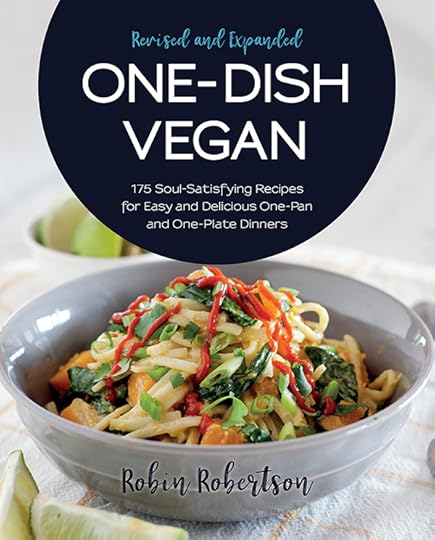 Many of you may be familiar with the first edition of One-Dish Vegan that came out over five years ago. I’m excited to announce the publication of the Revised and Expanded Edition. In it, you will find all of the favorites you’ve come to love, along with 25 all-new recipes, and more for a total of 175 fast and convenient one-dish meals, all beautifully photographed, and ready to get you cooking.
Many of you may be familiar with the first edition of One-Dish Vegan that came out over five years ago. I’m excited to announce the publication of the Revised and Expanded Edition. In it, you will find all of the favorites you’ve come to love, along with 25 all-new recipes, and more for a total of 175 fast and convenient one-dish meals, all beautifully photographed, and ready to get you cooking.
 The bold and vibrant recipes range from the most popular categories of one-dish dining like stews, chilis, and casseroles, to a host of stove top sautes and stir-fries. You will also enjoy substantial salads, as well as pastas and other noodle-based dishes. Convenience and easy cleanup are key in One-Dish Vegan; not only can each meal be served and enjoyed in a single dish, but most can also be prepared in a single container. Now you can spend more time eating and less time cleaning.
The bold and vibrant recipes range from the most popular categories of one-dish dining like stews, chilis, and casseroles, to a host of stove top sautes and stir-fries. You will also enjoy substantial salads, as well as pastas and other noodle-based dishes. Convenience and easy cleanup are key in One-Dish Vegan; not only can each meal be served and enjoyed in a single dish, but most can also be prepared in a single container. Now you can spend more time eating and less time cleaning.
The 25 all-new recipes in One-Dish Vegan Revised and Expanded Edition include:
Easy Ramen Bowls
Cheesy Cauliflower Soup
Panzanella Salad with White Beans and Artichokes
Barbecued Jackfruit with Sweet Potatoes and Cauliflower
Jungle Curry
Thai Coconut Rice with Edamame and Asparagus
Vegan Shakshuka
Jackfruit Stroganoff
Millet and Chickpea Curry
One-Pot Sicilian Couscous
Spicy Korean Stir-Fry
Lobster Mushroom Newburg
Vegetable Donburi
Coconut Curry Noodles and Butternut Squash
Black Bean Tortilla Casserole
Layered Brunch Bake
Shepherd’s Pie, Two Ways
Nacho-Chilaquile Bake
Lentil Tourtiere
 The recipes in One-Dish Vegan Revised and Expanded Edition are at once homey and adventurous, comforting and surprising. Above all, they demonstrate that it really is possible to get a complete vegan meal into one dish, full of good-for-you nutrients and bright, satisfying flavors.
The recipes in One-Dish Vegan Revised and Expanded Edition are at once homey and adventurous, comforting and surprising. Above all, they demonstrate that it really is possible to get a complete vegan meal into one dish, full of good-for-you nutrients and bright, satisfying flavors.
One-Dish Vegan Revised and Expanded Edition will be released on October 9 and is now available for pre-order.
The post One-Dish Vegan Revised and Expanded Edition appeared first on Robin Robertson.












September 25, 2018
Sesame Mochi
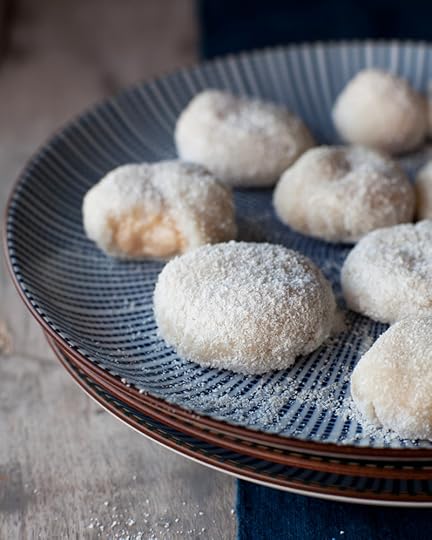 The Japanese confection known as daifuku mochi are small, smooth rice cakes or balls stuffed with a sweet filling. Mochi are made with mochiko, a flour made from ground sweet glutinous rice called mochigome. For daifuku mochi, the rice is pounded into paste, stuffed with a filling (usually sweet red bean paste) and molded into various shapes. They are often coated in a fine layer of cornstarch, potato starch, or confectioners’ sugar to keep them from sticking. These treats are eaten year-round, but are also a traditional food for the Japanese New Year. I admit I was never a fan of the traditional red bean paste filling, but when I tried them with a sesame filling, I was hooked. The microwave method used in this Sesame Mochi recipe was developed by Eleanor Urakawa, a mochimaker for thirty years, living in Hawaii.
The Japanese confection known as daifuku mochi are small, smooth rice cakes or balls stuffed with a sweet filling. Mochi are made with mochiko, a flour made from ground sweet glutinous rice called mochigome. For daifuku mochi, the rice is pounded into paste, stuffed with a filling (usually sweet red bean paste) and molded into various shapes. They are often coated in a fine layer of cornstarch, potato starch, or confectioners’ sugar to keep them from sticking. These treats are eaten year-round, but are also a traditional food for the Japanese New Year. I admit I was never a fan of the traditional red bean paste filling, but when I tried them with a sesame filling, I was hooked. The microwave method used in this Sesame Mochi recipe was developed by Eleanor Urakawa, a mochimaker for thirty years, living in Hawaii.
Note: Glutinous rice flour, also called mochiko, is available at Asian markets or online.
Sesame Mochi

The Japanese confection known as daifuku mochi are small, smooth rice cakes or balls stuffed with a sweet filling. Mochi are made with mochiko, a flour made from ground sweet glutinous rice called mochigome. For daifuku mochi, the rice is pounded into paste, stuffed with a filling (usually sweet red bean paste) and molded into various shapes. They are often coated in a fine layer of cornstarch, potato starch, or confectioners’ sugar to keep them from sticking. Note: Glutinous rice flour, also called mochiko, is available at Asian markets or online.
1 1/4 cups glutinous rice flour (mochiko) ((see headnote))
1/3 cup sugar
Pinch salt
1 1/4 cups almond milk
1/3 cup sesame paste
1/3 cup cooked white beans
2 tablespoons confectioners’ sugar
2 tablespoons toasted sesame seeds
Coconut flour or finely ground unsweetened coconut, for dusting
In a heatproof bowl, combine the flour, sugar, and salt. Stir in the almond milk and mix well. Cover with plastic wrap and microwave for 5 minutes, then uncover and set aside to cool for 5 minutes. Cut into twelve pieces.
In a food processor, combine the sesame paste, white beans, confectioners’ sugar, and sesame seeds and mix well. Set aside.
Dust your hands with coconut flour, then flatten each piece of mochi into a small disk. Place 1 1/2 teaspoons of the sesame mixture in center of each piece of mochi. Pinch closed to seal, then lightly roll it into a ball, using both palms. Repeat with the remaining mochi and filling.
Pour about 1/2 cup of coconut flour into a shallow bowl. Roll the balls in the coconut flour to keep the mochi from sticking. Transfer to a plate and serve. Mochi will keep for up to 2 days at room temperature. If not using right away, they will keep in the freezer for up to 2 weeks. Do not refrigerate, or they will become hard.
This recipe is from Vegan Without Borders © Robin Robertson, 2014, Andrews McMeel Publishing, photo by Sara Remington.
The post Sesame Mochi appeared first on Robin Robertson.












Robin Robertson's Blog
- Robin Robertson's profile
- 59 followers


